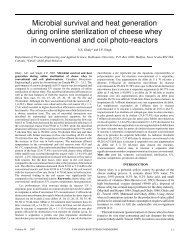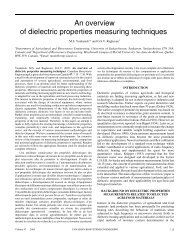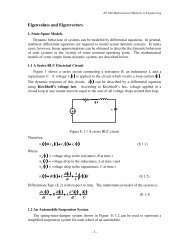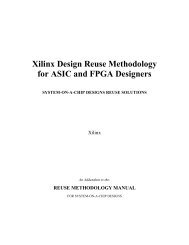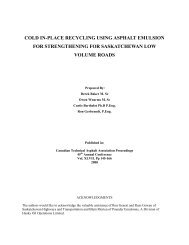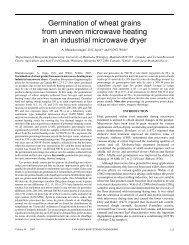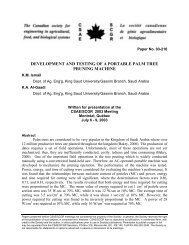Full Depth Cold-in-Place Recycling/Stabilization for Low Volume ...
Full Depth Cold-in-Place Recycling/Stabilization for Low Volume ...
Full Depth Cold-in-Place Recycling/Stabilization for Low Volume ...
You also want an ePaper? Increase the reach of your titles
YUMPU automatically turns print PDFs into web optimized ePapers that Google loves.
ABSTRACT<br />
Gra<strong>in</strong> transportation rationalization, economic diversification and value added <strong>in</strong>itiatives with<strong>in</strong><br />
the Saskatchewan economy has <strong>in</strong>creased commercial truck traffic on many Saskatchewan roads<br />
and will cont<strong>in</strong>ue to do so <strong>in</strong> the <strong>for</strong>eseeable future. These <strong>in</strong>creases <strong>in</strong> commercial truck traffic<br />
hold significant and often-immediate implications <strong>for</strong> Saskatchewan secondary roads (roads<br />
traditionally with ESALs of between 100 and 1000) because many of these roads were not<br />
designed to accommodate significant numbers of heavily loaded commercial trucks. Of<br />
particular concern, is the approximately 8600 km of th<strong>in</strong> membrane surfaced (TMS) roads of<br />
which many are experienc<strong>in</strong>g accelerated and at times, catastrophic damage. TMS roads are of<br />
particular concern because they are expensive to repair once surface breaks occur and TMS<br />
roads can be particularly sensitive to truck load<strong>in</strong>g when subgrades are thaw-weakened. As a<br />
result, <strong>in</strong>creas<strong>in</strong>g commercial truck traffic has translated <strong>in</strong>to a clear need to strengthen many<br />
Saskatchewan TMS and other secondary highways.<br />
Although preserv<strong>in</strong>g the Saskatchewan secondary road network us<strong>in</strong>g conventional methods is<br />
both technically feasible and economically tenable <strong>in</strong> some situations, conventional methods are<br />
not economically feasible <strong>for</strong> many low volume roads <strong>in</strong> the time frame required to provide an<br />
susta<strong>in</strong>able level of service that serves the immediate needs of the commercial road transport<br />
<strong>in</strong>dustry across the entire secondary road network. As a result, alternative and <strong>in</strong>novative road<br />
strengthen<strong>in</strong>g solutions are required. This paper presents the technical and economic case study<br />
of pilot test sections constructed by the Preservation and Operations Branch of Saskatchewan<br />
Highways and Transportation to evaluate alternative full-depth cold <strong>in</strong>-place recycl<strong>in</strong>g and<br />
strengthen<strong>in</strong>g techniques on Control Section 19-06.<br />
2



